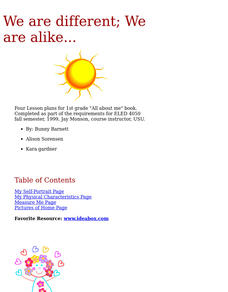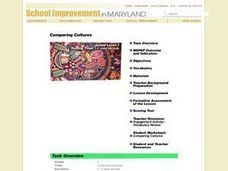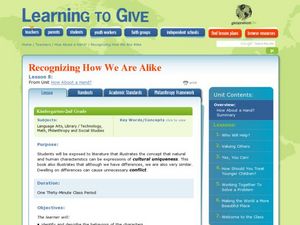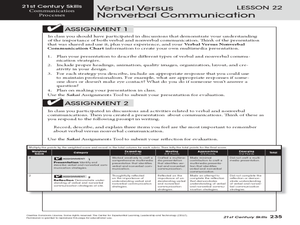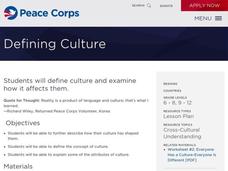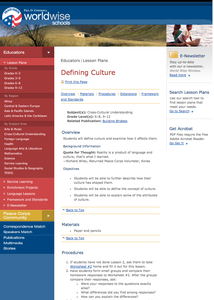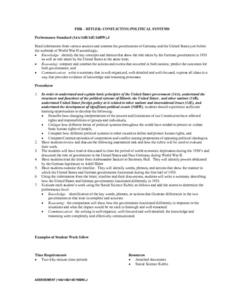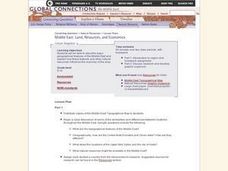Curated OER
How We Are Alike And Different
Pupils engage in a lesson that is concerned with the similarities and differences as part of knowing other children. They use examples of different drinks to illustrate the differences or similarities that are present in the student...
Curated OER
The Flow of Women's Work: How Cultures are Alike and Different?
Students examine gender roles in various cultures. In this flow of women's work lesson, students compare water related work in rural Africa to that in their own households.
Curated OER
Where Is Japan? How Are We Alike And Different?
First graders use literature, maps, and globes to explain how physical environments in various parts of the world are similar to and different from one's own, and that certain areas have common characteristics and can be called regions.
Curated OER
Getting to Know You
Students converse with each other while playing a game in order to discover things that are alike and things that are different about themselves. The students gather data about themselves, organize and display data on the graph, and...
Peace Corps
Defining Culture
How has culture shaped you? Middle and high schoolers examine different aspects of one's culture, including religious beliefs, social customs, and family traditions, and discuss the ways that their personalities have been formed by these...
Curated OER
We Are Different; We Are Alike........
First graders explain that everybody is unique in their own way by participating in this lively, art and language based series of lesson plans. They would greatly benefit from engaging in these plans in the beginning of the year as an...
Curated OER
Comparing Cultures
Young readers compare two stories/cultures, identifying how they are alike and different. They share their own version of a well-known story and adapt it to another culture. They explain their adaptations.
Curated OER
Simon Says "Who Are You?"
Students explore their similarities and differences. In this getting to know you instructional activity, students play a variation of "Simon Says," according to various personality and physical traits.
Curated OER
Recognizing How We Are Alike
Young scholars explore the concept of social justice. In this service learning worksheet, students read The Sneeches in order to appreciate cultural uniqueness.
Curated OER
Understanding and Fighting Stereotypes through Words and Images
Use some provocative modern art to get your class considering stereotypes and the impact they have on us all. Your class will discuss the print art Indian Look-Alike by Melanie Yazzie and stereotypes in general before...
Curated OER
Verbal Versus Nonverbal Communication
Young scholars create a multimedia presentation. They will complete a verbal versus non-verbal communication chart to create a multimedia presentation which will include the different types of communication strategies. Then answer a...
Curated OER
Ways we are Alike/ Ways we are Different
Students complete a chart comparing and contrasting African villages with their own communities. The lesson focuses on the Mbuti and Fulani people. They explore their style of living, their traditions and everyday life in these villages.
Curated OER
Defining Culture
Students examine the role that culture plays in forming beliefs and behaviors. In this culture instructional activity, students describe the attributes of their culture and explain how their culture shapes them.
Denver Art Museum
Putting Images into Words
Engage your class in art analysis of Indian Look-Alike by Melanie Yazzie. Using this work of art as inspiration, writers compose a poem or short story. After a peer review session, the teacher conveys information about the work of art as...
Curated OER
I Am Special and You Are Special Too #5
The student create a drawing of themselves through the use of multicultural people color crayons. They explain to a teacher what makes them special. Students investigate family types, skin color, eye color, hair color, and favorites.
Curated OER
Defining Culture
Students define culture and examine how it affects them. They describe how their culture has shaped them, define the concept of culture, and explain some of the attributes of culture. The research the customs and culture of the groups...
Curated OER
FDR-Hitler: Conflicting Political Systems
Students compare and contrast the governments of the United States and Germany during World War II. Using different media, they identify the actions of both countries during the war and their major mistakes. They write a short summary...
Curated OER
Defining Culture
Learners explore cultural diversity. In this cultural awareness lesson, students examine the similarities and differences in various cultures and discuss the value of these differences.
Curated OER
Middle East: Land, Resouces, and Economics
High schoolers identify and describe major geographical features of the Middle East and explain how these features and other natural resources influence the economy of the area. Then they research one of the middle-eastern countries...
Curated OER
Memory Game
Students interact with different explorers and their motivations for exploration. They make a deck of memory cards. Students use 20 specific motivational factors in making their cards. They then play their game.
Curated OER
Pros and Cons of Advertising
Twelfth graders compare and contrast television commercials. They write paragraphs explaining how different company commercials for the same product can confuse consumers.
Curated OER
Communities
Students examine the similarities and differences between rural, suburban, and urban communities. They read about type of community in their social studies textbook, analyze the differences between Tokyo and Chicago, and complete a chart...
Curated OER
Honoring Leaders
Students design and compare monuments that honor an imaginary Roman emperor and a future American president. They explain how the monuments reflect the attributes of the person being honored.
Curated OER
Tools of the Trade
Students create and then play a game similar to Memory, which encourages them to recall what they have learned about different occupations and the related tools.







